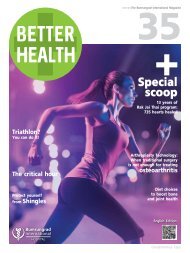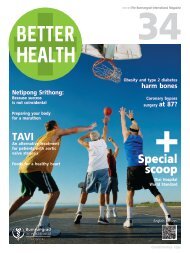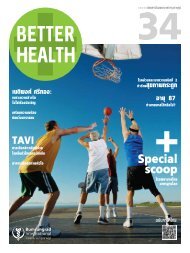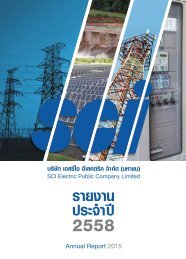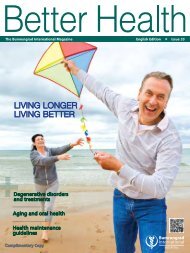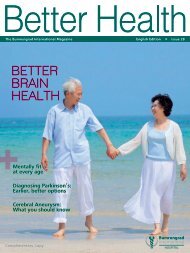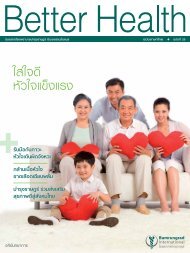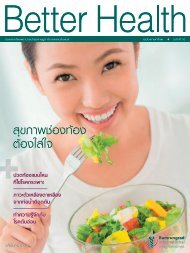Better Health 25 Eng
The magazine for patients and friends of Bumrungrad International Hospital, Thailand.
The magazine for patients and friends of Bumrungrad International Hospital, Thailand.
- TAGS
- bumrungrad
- hospital
- thailand
Create successful ePaper yourself
Turn your PDF publications into a flip-book with our unique Google optimized e-Paper software.
Senior-suitable exercises<br />
The right types of exercise for younger adults aren’t<br />
necessarily appropriate for seniors, especially those being<br />
treated for certain medical conditions. “It’s important that<br />
seniors avoid high-resistance and high-intensity exercises,”<br />
Dr. Suthee advises. “I always recommend my senior patients<br />
include exercises targeting different areas of the body, and<br />
be sure their exercise routine is ‘slow but consistent’ and<br />
‘low resistance’.” <br />
Following are some of the best, most comprehensive<br />
exercises to boost senior body performance and improve<br />
overall health and fitness: <br />
Increased joint mobility. Range-of-motion exercises <br />
can be performed by moving each joint through its full <br />
range of motion. For example, for shoulder mobility, <br />
slowly raise one arm above the head as high as possible; <br />
repeat five to ten times for each shoulder. <br />
Stronger muscles. Resistance training strengthens the <br />
core muscles involved in body movement. These include <br />
leg, hip and back muscles. Light weightlifting, push-ups <br />
done against a wall, and hand- and leg-raisers are all <br />
effective muscle builders for seniors. <br />
Exercise exertion: Is your workout too intense?<br />
Exercise is fundamental to healthier living. But pushing yourself too hard or for too long can turn a good thing <br />
into something harmful, especially for senior adults. One way to measure your level of exercise exertion is to use<br />
the Borg Rating of Perceived Exertion (RPE). The Borg Scale assigns a numerical value from 6 to 20, as detailed<br />
below, based on the physical sensations a person feels during exercise.<br />
Perceived<br />
Exertion<br />
Score<br />
Exercise intensity Physical sensations Target Heart Rate<br />
6-7<br />
8-9<br />
10-11<br />
No exertion at all<br />
Very light exertion<br />
Light exertion<br />
How you feel when lying in bed, watching<br />
TV, or relaxing in a comfortable chair.<br />
Little or no effort. <br />
60% of maximum heart rate<br />
12-13 Moderate/Medium exertion Feels like you can exercise for hours, easy<br />
to breathe and to speak. <br />
14-15 Hard / Heavy exertion Feels energetic enough to exercise for hours,<br />
breathes heavily, can only carry on brief<br />
conversation. <br />
16-17 Very strenuous exertion Discomfort, very difficult to maintain exercise<br />
intensity, barely able to breathe or speak. <br />
60% of maximum heart rate<br />
70% of maximum heart rate <br />
80% of maximum heart rate <br />
18-20 Extremely hard to<br />
maximum exertion <br />
Feels almost impossible to keep exercising,<br />
feels completely out of breath. You are exercising<br />
dangerously hard.<br />
90% of maximum heart rate<br />
DANGER! DO NOT EXERCISE AT<br />
THIS LEVEL OF INTENSITY!<br />
REMINDER: For seniors planning to check their exercise intensity using the Borg Scale, it’s<br />
important that workout intensity be maintained within the “Moderate/Medium exertion” or<br />
“Hard/Heavy exertion” ranges, i.e. within a rating range of 12 to 15.




